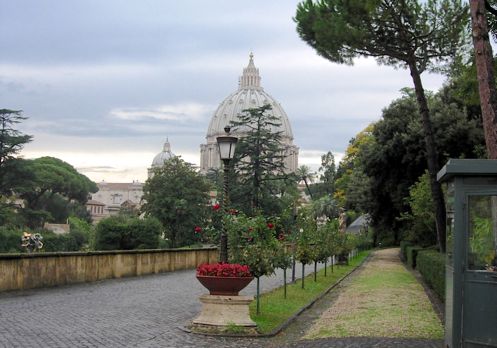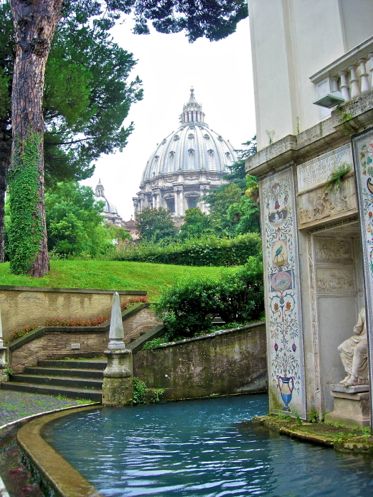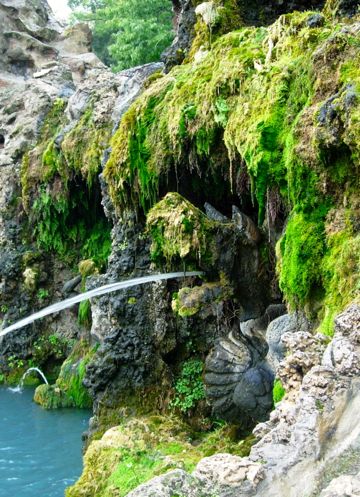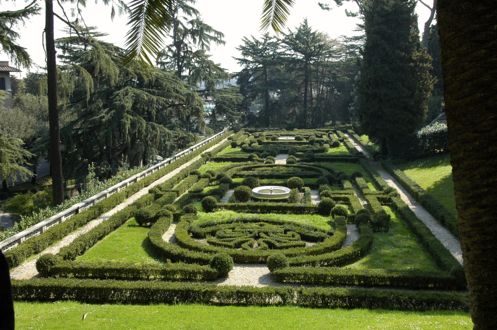If I Were a Cardinal

If I were a cardinal, about to elect a new pope, I would take my duty very seriously. Yet, as I was walking solemnly into the Sistine Chapel, singing “Veni Creator Spiritus” and mindful of the immense responsibility resting on my shoulders, I would harbor one tiny secular thought: that when the untold days of silence and voting had passed, and white smoke had ascended the specially erected copper chimney, I would slip out to stroll through the incomparable Vatican Gardens.

Rome’s oldest surviving gardens, they are incomparable, in part, because of their the history and the grandeur of the Vatican, but also because they are simply gorgeous. Gardens, like super Tuscan’s, gelato, and tartufo bianco di alba, are among the things at which Italians excel. Italian Renaissance garden designers instinctively knew how to combine water, views, stonework, woodland, and whimsy, and the result is a legacy of gardens renowned for their extraordinary beauty and that have since inspired countless garden designers.
The complex Vatican gardens, originally laid out by Bramante who had been commissioned in 1503 by Pope Julius II (1445-1513), are a wonderful example. They take up nearly half of Vatican City’s 108 acres and have been used by popes as a place of contemplation, ceremony, and production of vegetables and fruit since the 13th century. Bordered on one side by St. Peter’s Basilica and the Vatican Museums, they are otherwise surrounded by medieval walls and encompass buildings that date back to the 9th century. Each pope has left his mark on the gardens since. The contribution of Pope Paul VI (1963-1978) was a very modern heliport.
As a cardinal, I surely would have had opportunities to visit the gardens on past trips to Rome, and would have scoped out spots that I would be eager to see again, especially the fountains. With the multiple natural water sources and changes of grade in Italy’s eternally beautiful landscape, it was probably inevitable that Italian garden designers would invent fantastic fountains. According to author Elizabeth MacDougall, “the story of the development of Roman fountains begins at the Vatican…” Today, at least 100 fountains trickle, gush, and murmur within the Vatican walls. The 100th was added in 2010.

My first destination, then, might be the Casina Pia. The Casina, started by Pope Paul IV ((1558-89) and finished by Pope Pius IV ((1559-1565), was referred to as “a fountain in the woods” though it is actually at the edge of a wooded area. It is a small complex of buildings around a stunning terrace, and with a magnificent loggia intricately decorated with mosaics and sculpture. Now part of the Pontifical Academy of Sciences, the Casina’s loggia is one of the single most beautiful garden buildings I have ever seen. Its murmuring fountains would entice me to sit and contemplate its three statues, Youth, Virtue, and the pagan goddess, Cybele, while resting in the cool quiet of the space. The multiple urns of spiky yucca, a drought tolerant plant, complements the abundance of water in this garden, however incongruously.

As if the interior space of the Villa’s courtyard isn’t beautiful enough, the lower fountain, with its lovely blue basin of spilling water and mosaic walls is truly stunning. Though my eyes would be attracted by the interplay of water, light and sculpture, inevitably they would stray to the left. There I would take in one of my favorite views of the dome of St. Peter’s. It would not be easy to move on.

Nevertheless, I would want to revisit the Fountain of the Eagle, built by a Dutch sculptor for Pope Paul V (1605-1621). This fountain, started in 1611 is very unlike the Casina Pia. It is a rustic combination of natural stone on top of which stands a proud eagle, the symbol of the Borghese family. Once surrounded by vineyard and woods, the fountain’s jets of water spurt from hidden lead pipes into a basin in which swim little figures. My favorite features are the water-spouting dragons on either side. Over their long tenure they have grown mossy manes and beards that mitigate their ferocity, and they almost seem like cartoon characters. It is not impossible that the creators of Scooby Doo found inspiration in them. Behind the Fountain of the Eagle stands the Mater Ecclesiae Monastery where Pope Benedict will purportedly live out his retirement.

The details of the Vatican Gardens, in spite of their size and gravity, would definitely amuse me. I would return to The Fontana della Ranocchie (Fountain of Frogs), a small, round fountain in the shadow of the immense medieval wall, to be sure the little bronze frogs were still there, spouting clear sparkling water into the fountain’s reedy center. I would also walk past the Fountain of the Spinster, the statue of which is said to date back to the first century, and is supposed to have some association with Lucretzia Borgia. I would linger on my way through the gardens to wonder from where various pieces of statuary, some just abandoned remnants of ancient Roman, had come.

I would certainly make my way to the Italian Garden, added by Pope Pius XI (1857-1939). Set on a level terrace on the hillside and emblematic of a revival in Renaissance gardens, its clipped geometry of dark box hedges are dramatically set off by light grass-green spaces and beige walks. Again, enticed by water, I would be compelled to walk into the garden to hear to my footsteps crunching on gravel and the spilling of water from a pair of basins near the center of the garden. The surrounding trees include enormous cedars, cypress, firs, pines, and palm trees and I would stop to admire their majesty and diversity.
Ever a plantsman, I would take note of the remarkable diversity of plants and trees that have taken root in the gentle and nurturing Roman climate throughout the gardens. There is an olive tree that was given by the nation of Israel in 1995 to mark the first anniversary of the establishment of diplomatic relations with the Holy See. There are enormous dawn redwoods (Metasequoia glyptostroboides) from China, an Australian silk-oak (Grevillea robusta), magnolias from North American, and shrubs from all over the world.
Alas, I am no cardinal and am not planning to visit the Vatican any time soon. I think I will wander over to Dumbarton instead to enjoy its vistas, terraces, and fountains laid out by Beatrix Farrand. She, like her aunt Edith Wharton, was inspired by Italians gardens and gracefully combined this inspiration with French influences and Dumbarton’s Italian-like hilly topography. It will suffice.
If you are planning to go to Rome, however, the good news is that one needn’t be a Cardinal nor to wait for the selection of a new pope to visit the gardens. In fact, they are now closed until the conclave is over. Click here for tickets.
